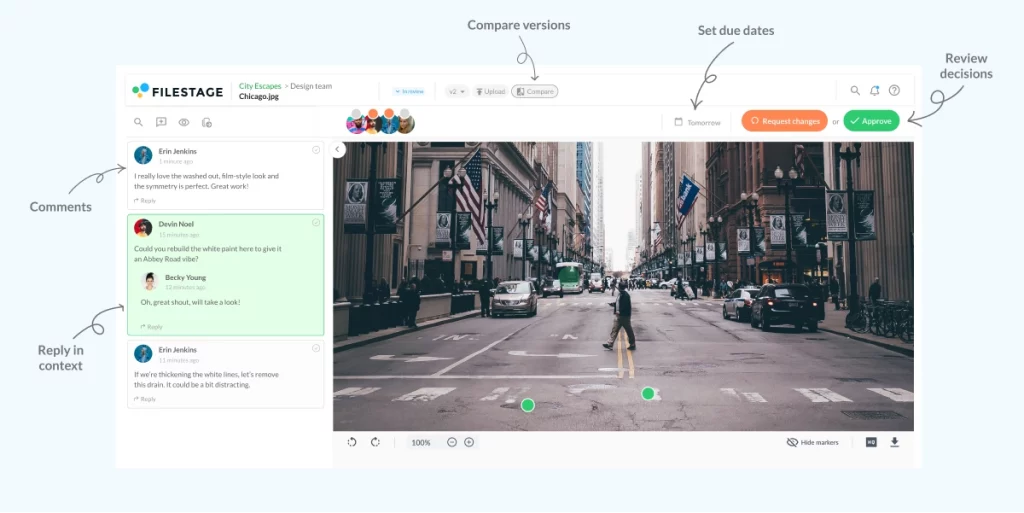Healthcare marketing is a different beast.. With its strict regulations and specific goals and practices, healthcare organizations have always been shy to accept some of the trendiest marketing practices.
But if you take a look at the marketing budgets, you’ll quickly see that there’s quite a lot of space for advanced marketing solutions and practices. According to Statista, healthcare providers spent nearly $14 billion on marketing in 2021.
And with things like patient experience, AI, and personalized treatments penetrating the world of digital marketing, the healthcare industry is showing its readiness to enter the big leagues.
So here’s an overview of some of the biggest trends in healthcare marketing for 2024 and all the ways you can implement them at your organization.
1. Personalized patient experiences
Personalized customer experience is a trend that we’ve been witnessing grow across all the industries in the last couple of years. And in healthcare your customers are your patients, so it’s especially important to optimize their experience.
Luckily, advanced technologies like AI and machine learning are quite helpful in this area. They allow you to personalize your communication and tailor it entirely to each patient.
This way, you can predict patients’ needs and deliver personalized information to them just when they need it. You can even use AI to adjust their therapy according to their needs.

How to implement this trend
Here are the three best ways healthcare marketers can start personalizing their patients’ experience.
1. Use data analytics
Data analytics are a powerful asset in personalizing your marketing efforts. With data analytics you can collect important information about your patients and turn it into valuable insights that help you tailor your marketing communication.
Here are some ways data analytics can help you provide a personalized patient experience:
- Use demographics and behavioral data to improve your targeting and make sure you send relevant information to your patients
- Use predictive analytics to anticipate patients’ needs based on historical data, identify their risk for certain conditions, and promote preventive care
- Personalize your communication with customized content on your patients’ preferred channels
- Improve patient experience by using their feedback to improve your products and communication
- Use analytics to design and implement loyalty programs that reward repeat purchases, encouraging retention
Supercharge your marketing reviews
Share, review, and approve all your content in one place with Filestage.
2. Implement CRM systems
Customer relationship management (CRM) systems are your best friend when it comes to personalizing your patient communication. These tools help you centralize patient data, segment it based on various criteria, and send out tailored communications to each of your patients.
Here are some CRM systems specifically tailored for healthcare marketing:
- Salesforce Health Cloud
- Zoho CRM for Healthcare
- HubSpot CRM for Healthcare
- Microsoft Dynamics 365 Healthcare Accelerator
3. Implement AI and machine learning
Another powerful way to personalize patient experience is with the use of AI and machine learning technologies. With the help of AI you can analyze vast amounts of data in a short period, identify patterns, and predict your patients’ needs.
This means that you can combine data from various sources (including your CRM and patient feedback) to create a comprehensive view of each patient.
Then, with a full 360-degree patient view, you can create more personalized marketing approaches and create customized treatment plans for each of your patients.
2. Telehealth platforms
Looks like Zoom calls and remote communication are no longer reserved for work chat. More and more healthcare organizations are finding innovative ways to help as many patients as possible – even remotely.
They’re designing various apps and platforms where patients can go and schedule one-on-one phone calls with healthcare professionals to help them solve minor health issues. This way patients can get their treatments faster and on-site doctors can focus on more complicated cases.
How to implement this trend
Here are three ways you can implement telehealth platforms as part of your healthcare marketing strategy.
1. User-friendly platforms
When it comes to building a platform for the general public, one thing is clear – it has to be as user-friendly as possible. Your patients can come from all sorts of backgrounds and they’re not necessarily as tech savvy as you may think.
That’s why you’ll need to invest in intuitive telehealth platforms that are easy for all patients to navigate.
Here are four amazing examples of telehealth platforms and the services they offer:
- Teladoc Health – general medical consultations, mental health support, chronic condition management, dermatology, and wellness care
- Amwell – urgent care, behavioral health, nutrition counseling, women’s health, and specialist consultations
- Doctor on Demand – urgent care, behavioral health (therapy and psychiatry), preventive health, and chronic disease management
- MDLive – urgent care, primary care, behavioral health, dermatology, and pediatrics
2. Offer training programs
Another thing to consider when implementing a telehealth platform is to offer additional training to both a healthcare provider and your patients. This can be in the form of a written document available on your website, or as a live Zoom session.
Combine that with a responsive customer service team, you won’t have any problem getting people to use your platform.
3. Create marketing campaigns
Telehealth programs are still relatively new to most people. While some don’t even know this option exists, others are skeptical and not quite sure what kind of help they can get from it.
To make sure every patient learns about your platform and all the services you offer, you can create original healthcare marketing campaigns. Highlight the benefits of this type of treatment and help your prospective patients get a better understanding of how your services work.
You can do this by creating targeted ads, through social media promotion, or with a dedicated patient newsletter.
3. AI chatbots
We can all agree that 2023 was the year that AI hit the mainstream. This year, things are no different. And one of the most powerful and common uses of AI in healthcare marketing is chatbots.
AI-driven chatbots can help you increase patient engagement, streamline communication, and provide personalized patient experiences.
They are often used for providing instant support for the patients as part of telehealth platforms, to help you personalize patient communication, or efficiently schedule patient appointments.

How to implement this trend
Here’s how to implement AI-driven chatbots in your healthcare marketing strategy.
1. Use AI chatbots for automated patient surveys and feedback collection
Getting direct patient feedback about your product or service is the most valuable information you can get. But, traditional surveys take time and effort, and most patients aren’t motivated to respond.
Thanks to AI chatbots, you can engage patients more naturally and improve your chances of collecting valuable feedback. And the more responses you get, the more you can improve your services.
Here are some patient surveys you can create to collect valuable patient feedback:
- Post-appointment surveys – After a patient visits a clinic or has an appointment, the AI chatbot can automatically send a survey to gather feedback on their experience.
- Continuous patient engagement – AI chatbots can periodically check in with patients to gather ongoing feedback about their health and satisfaction with the services they’re using.
- Campaign feedback – When running a specific marketing campaign, like a new wellness program, AI chatbots can help you collect feedback on these initiatives.
- Analyzing patient sentiment – AI chatbots can analyze the language and tone of patient feedback to measure overall sentiment. This can help you identify trends and common themes, giving you more insights into what each patient cares about the most.
2. Implement virtual assistants
One of the most revolutionary things in healthcare marketing is the use of virtual assistants. These assistants can help you with patient scheduling, medication reminders, and follow-up care.
For example, you can implement a virtual assistant as a part of your cardiovascular treatment for the elderly. Besides offering medicine to your patients, you can also provide them with a virtual assistant to remind them when to take their medication.
This will improve the quality of your treatment and increase patient retention by offering value on top of the prescribed medication.
4. Influencer partnerships
Influencer partnerships are a powerful marketing tool in every industry. Influencers have the power to connect with their audience in a way that no other marketing initiative can. And this is especially true for healthcare companies.
Seeing someone else experience the same health issues and find a way to overcome them creates a more emotional connection between your brand and potential patients. That’s why finding the right influencer partnership can be one of the most efficient ways to attract new patients to your products.
How to implement this trend
Here are the three things to focus on when building influencer partnerships.
1. Identify relevant influencers
Good influencer marketing is all about aligning your brand values with influencers’ values. You need genuine users that believe in your product and can promote it authentically. This is especially true when it comes to healthcare products.
To find the right influencer for your brand, try these influencer marketing platforms:
- Influencity
- HypeAuditor
- InfluencerMarketing.ai
2. Work on collaborative content
Influencer marketing isn’t just about finding the right influencer and letting them do whatever they wish with the promotion of your product. It’s about creating a good collaboration with them to adequately promote your products while staying true to their own personal brand and style.
To make sure you create a smooth collaboration with your influencers, without anyone going nuts during the review process, you can try using a review and approval tool like Filestage.
The tool allows you to bring all your collaborative content together with your influencers in one feedback and approval platform. This increases the speed of your content production and helps you make sure no unapproved content ever gets published!

3. Focus on tracking and analytics
The final step in every healthcare campaign should be setting up tracking to monitor its success. And the same goes for influencer marketing. Once you agree on the objectives of your campaign, set up the tracking for the right metrics, and track the performance of the influencers campaign. Then you can adjust your strategy over time to maximize ROI.
5. Search engine optimization (SEO)
Last year, Google released a statement saying that 5% of all its searches are health related. That’s close to 100 billion searches each year!
As a result, more and more healthcare companies are tapping into the power of content marketing and finding ways to use it for their brand.
One of the reasons for this is that the healthcare industry often sells complex products for specific issues, and patients need a level of education to know whether the product fits their needs.
By using content marketing as a less invasive advertising channel, your healthcare organization can turn its marketing efforts in a more educational direction.
How to implement this trend
Here are the three most efficient ways to use SEO as part of your healthcare marketing efforts.
1. Perform keyword research
The first step in optimizing your content for SEO is identifying relevant keywords for your healthcare services. Find keywords that could be connected to your product or a service, search their volumes, and which keywords make the most sense for Google.
In this process, you’ll need the help of tools like Ahrefs or Semrush. These are dedicated keyword exploration tools that tell you all about how much a specific keyword gets searched for in each country. They can also give you insights into whether it’s better to focus on the keyword you’re looking for or to search for a related term.
2. Work on content optimization
Once you know the keywords you’re trying to rank for, it’s important to optimize all your current website content, and start creating new optimized content.
Here are some tips for optimizing your content for SEO:
- Check out the content that’s already ranking for your keyword and try to make a more insightful piece of content than the existing one
- Insert the main and supporting keywords in your content
- Write a meta title and meta description for all your pages
- Write alt text for each image
3. Localize your SEO efforts
If you have a smaller company that competes on a local market, one of the most successful strategies is to localize your SEO. This means finding a market where you attract the most of your audience and adjusting your language and the keywords to the market.
This will also help you reduce competition because most of the brands automatically compete for English keywords, making it more difficult for fresh brands to truly enter the SEO arena.
Final thoughts
Looking at these top healthcare marketing trends, it’s easy to conclude that healthcare practices are becoming more and more advanced. Patients are getting personalized treatments and companies care about patient satisfaction more than ever. And if you’re a healthcare marketer, it’s important to communicate this to your audience.
If you’d like to see how dedicated review and approval software can improve your marketing processes, check out Filestage. You can use the tool for free for seven days and see how it fits with your team’s workflow.




